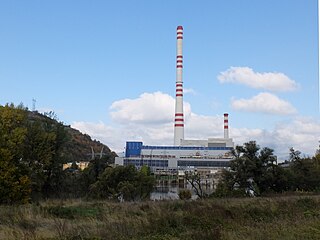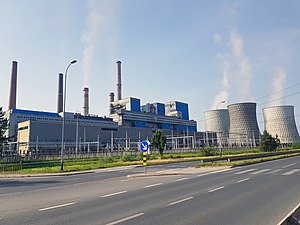
A fossil fuel power station is a thermal power station which burns a fossil fuel, such as coal or natural gas, to produce electricity. Fossil fuel power stations have machinery to convert the heat energy of combustion into mechanical energy, which then operates an electrical generator. The prime mover may be a steam turbine, a gas turbine or, in small plants, a reciprocating gas engine. All plants use the energy extracted from the expansion of a hot gas, either steam or combustion gases. Although different energy conversion methods exist, all thermal power station conversion methods have their efficiency limited by the Carnot efficiency and therefore produce waste heat.

NLC India Limited (NLC) is a central public sector undertaking under the administrative control of the Ministry of Coal, Government of India. It annually produces about 30 million tonnes of lignite from opencast mines at Neyveli in the state of Tamil Nadu in southern India and at Barsingsar in Bikaner district of Rajasthan state. The lignite is used at pithead thermal power stations of 3640 MW installed capacity to produce electricity. Its joint venture has a 1000 MW thermal power station using coal. Lately, it has diversified into renewable energy production and installed 1404 MW solar power plant to produce electricity from photovoltaic (PV) cells and 51 MW electricity from windmills.

Banovići is a town and municipality located in Tuzla Canton of the Federation of Bosnia and Herzegovina, an entity of Bosnia and Herzegovina. It is located in northeastern Bosnia and Herzegovina. The intensive development of Banovići began with the construction of the railway Brčko-Banovići in the year 1946. Due to its quality, brown coal from Banovići is well-known all over Europe.

The Ugljevik Power Plant is a coal-fired power plant in Ugljevik, Bosnia and Herzegovina. It is owned and operated by Rudnik i termoelektrana Ugljevik, a subsidiary of Elektroprivreda Republike Srpske. RiTE Ugljevik is an integrated coal mining and power generating company.

A coal-fired power station or coal power plant is a thermal power station which burns coal to generate electricity. Worldwide there are over 2,400 coal-fired power stations, totaling over 2,000 gigawatts capacity. They generate about a third of the world's electricity, but cause many illnesses and the most early deaths, mainly from air pollution.

The Turceni Power Station is situated in Gorj County, on the banks of the Jiu River, halfway between the cities of Craiova and Târgu Jiu.

The health and environmental impact of the coal industry includes issues such as land use, waste management, water and air pollution, caused by the coal mining, processing and the use of its products. In addition to atmospheric pollution, coal burning produces hundreds of millions of tons of solid waste products annually, including fly ash, bottom ash, and flue-gas desulfurization sludge, that contain mercury, uranium, thorium, arsenic, and other heavy metals. Coal is the largest contributor to the human-made increase of carbon dioxide in Earth's atmosphere.

Elektroprivreda BiH or JP Elektroprivreda Bosne i Hercegovine d.d. is a Bosnian public electric utility company with headquarters in Sarajevo, Bosnia and Herzegovina.

Kakanj Thermal Power Plant is one of Bosnia and Herzegovina's largest coal-fired power plant having an installed electric capacity of 450 MW and producing around 2.3 billion Kwh of electricity per year. The power plant is operated by Elektroprivreda Bosne i Hercegovine. The chimney of Kakanj Power Plant is 300 metres tall and is one of the tallest man-made objects built in former Yugoslavia.
Rovinari Coal Mine is an open-pit mining exploitation, the largest in Romania, located in Rovinari, Gorj County. The legal entity managing the Rovinari mine is the National Company of Lignite Oltenia which was set up in 1997.

Pljevlja Power Station situated in Pljevlja is the only coal-fired power station in Montenegro. It went into service in 1982 and has a generation capacity of 210 MW. It produces about a third of the state's electricity. The chimney of the power plant is 250 meters tall.

The North Chennai Thermal Power Station is a power station situated about 25 kilometres (16 mi) from Chennai city. It is one of the major power plants of Tamil Nadu and has a total installed capacity of 1,830 MW (2,450,000 hp).
TPP Kostolac is a coal fired thermal power plant complex operated by Elektroprivreda Srbije, located on the right bank of Danube river, in Kostolac, Požarevac. It is the second largest power plant in Serbia after TPP Nikola Tesla. Within the complex, there are 4 operational units as of October 2020. It makes around 10% of the total available capacity of the electric power system of Serbia and almost 11 percent of the total electric power production in EPS's system.
CEE Bankwatch Network is a global network which operates in central and eastern Europe. There are 17 member groups, multiple non-governmental organizations based in different locations; the network is one of the largest networks of environmental NGOs in central and eastern Europe. Bankwatch's headquarters rest in Prague, Czech Republic.

The Virginia City Hybrid Energy Center (VCHEC) is a power station located in St. Paul, in Wise County, Virginia. It is operated by Dominion Virginia Power, Dominion Resources Inc.'s electric distribution company in Virginia. The 600 MW plant began power generation in July 2012 after four years of construction. The plant deploys circulating fluidized bed boiler technology (CFB) to use a variety of fuel sources including bituminous coal, coal gob, and bio-fuels. VCHEC is placed under stringent environmental regulations by the Virginia Department of Environmental Quality (DEQ).

The Afşin-Elbistan power stations are coal-fired power stations in Afşin in Kahramanmaraş Province in Turkey. The area is a sulfur dioxide air pollution hotspot: Air pollution can be trapped by the surrounding mountains, and Greenpeace say that measurements they took nearby in late 2020 show illegal levels of particulates and nitrogen oxides. The Environment Ministry has not released the flue gas measurements.
Kemerköy power station is a 630 MW coal-fired power station in Turkey in Kemerköy, Muğla, completed in 1985, which burns lignite mined locally. Originally state owned by Electricity Generation Company it was sold in 2014 to Limak- IC İçtaş. In 2020 it received 140 million lira ($25,000,000) capacity payments.

Yeniköy power station is a 420 MW coal-fired power station in Turkey in Yeniköy, Muğla built in the late 20th century, which burns lignite mined locally. The plant is owned by Limak- IC İçtaş and in 2020 it received 93 million lira ($16,000,000) capacity payments. The area is a sulfur dioxide air pollution hotspot and as of 2017 the air pollution caused by Yeniköy and neighboring Yatağan power station and Kemerköy power station is estimated to have caused 45,000 premature deaths. It is estimated that closing the plant by 2030, instead of when its licence ends in 2063, would prevent over 7000 premature deaths.
Coal in Turkey generates between a quarter and a third of the nation's electricity. There are 54 active coal-fired power stations with a total capacity of 21 gigawatts (GW).















